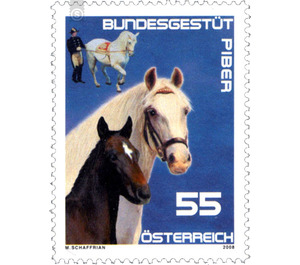horses - Austria / II. Republic of Austria 2008 - 55 Euro Cent
Theme: Animals
| Country | Austria / II. Republic of Austria |
| Issue Date | 2008 |
| Face Value | 55.00 |
| Edition Issued | 700,000 |
| Printing Type | offset |
| Stamp Type | Commemorative |
| Item Type | Stamp |
| Chronological Issue Number | 2068 |
| Chronological Chapter | OOS-OE2 |
| SID | 928164 |
| In 58 Wishlists | |
The Lipizzaner, also called Imperial Mold, is the Austrian horse breed from the glittering period of the Danube monarchy, Austria symbol and tourist attraction par Excellenze. For a long time, the Lipizzaner has been associated with the Spanish Riding School in Vienna, where the noble warmblood horses are trained according to classical equitation. As foals, they have a dark color and are only white when they are 4-10 years old. The type of Lipizzaner has not changed a good 300 years. He is an athletic horse, hardness and endurance characterize him, the movements are graceful, striking is his springy gait. The character of the horse is friendly and balanced. It learns fast, works with zeal and is very suitable for dressage and also as a carriage horse. The Federal Stud Piber is bred according to an old tradition. The best stallions are brought to Vienna to the Spanish Riding School for training at the age of four. Later, they return to the stud as stallions or "retired". The training of the stallions is tedious, because the Lipizzan is one of the late mature and long-lived breeds. Archduke Karl II of Austria founded in 1580 the near Trieste located stud Lipizza. The tribe formed five stallions of Spanish-Italian blood, which were crossed with down-to-earth karst horses. In Lipizza was over the centuries for the breeding of befitting horses for the Habsburg court. The body shape and color of the Lipizzaner horses corresponded to the baroque pompous horse. During the 18th and 19th centuries, six stallions were brought to Lipizza for breeding, including a pure-blooded Arab. They are considered the progenitors of today's breed, after them are still the male descendants named (Pluto, Conversano, Favory, Neaolitano, Siglavy, Maestoso). After the disintegration of the monarchy, Austria took over a large part of Lipizzaner, who found a new home in the federal stud Piber. During World War II, the stud horses were moved to Hostau, Czech Republic. In a secret action - which was filmed as "The wonder of white stallions" - was carried out with the help of the Americans, the evacuation of horses from the Russian-occupied area to Bavaria. In 1945 they were hired in Wimsbach near Wels, where the stallions of the Riding School from Vienna had been brought to. After the conclusion of the State Treaty, the Lipizzaners returned to Vienna and to Piber.


